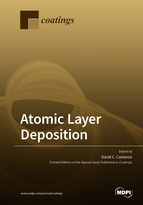Atomic Layer Deposition
A special issue of Coatings (ISSN 2079-6412).
Deadline for manuscript submissions: closed (31 October 2018) | Viewed by 45355
Special Issue Editor
Special Issue Information
Dear Colleagues,
Atomic Layer Deposition (ALD) has developed from its early beginnings in the Soviet Union and Finland into a process that is critical for microlectronics manufacturing and also extends into many other areas, for example, flexible electronics, displays, anti-corrosion layers, catalysis and pharmaceuticals. This Special Issue of Coatings on “Atomic Layer Deposition” is intended to cover original research and critical review articles on recent advances in all aspects of ALD.
In particular, the topics of interest include, but are not limited to:
- ALD processes for materials and devices;
- Characterization of ALD coatings;
- ALD nucleation, growth phenomena and process modelling;
- Applications of ALD;
- Spatial and roll-to-roll ALD processes.
Prof. Dr. David Cameron
Guest Editor
Manuscript Submission Information
Manuscripts should be submitted online at www.mdpi.com by registering and logging in to this website. Once you are registered, click here to go to the submission form. Manuscripts can be submitted until the deadline. All submissions that pass pre-check are peer-reviewed. Accepted papers will be published continuously in the journal (as soon as accepted) and will be listed together on the special issue website. Research articles, review articles as well as short communications are invited. For planned papers, a title and short abstract (about 100 words) can be sent to the Editorial Office for announcement on this website.
Submitted manuscripts should not have been published previously, nor be under consideration for publication elsewhere (except conference proceedings papers). All manuscripts are thoroughly refereed through a single-blind peer-review process. A guide for authors and other relevant information for submission of manuscripts is available on the Instructions for Authors page. Coatings is an international peer-reviewed open access monthly journal published by MDPI.
Please visit the Instructions for Authors page before submitting a manuscript. The Article Processing Charge (APC) for publication in this open access journal is 2600 CHF (Swiss Francs). Submitted papers should be well formatted and use good English. Authors may use MDPI's English editing service prior to publication or during author revisions.






